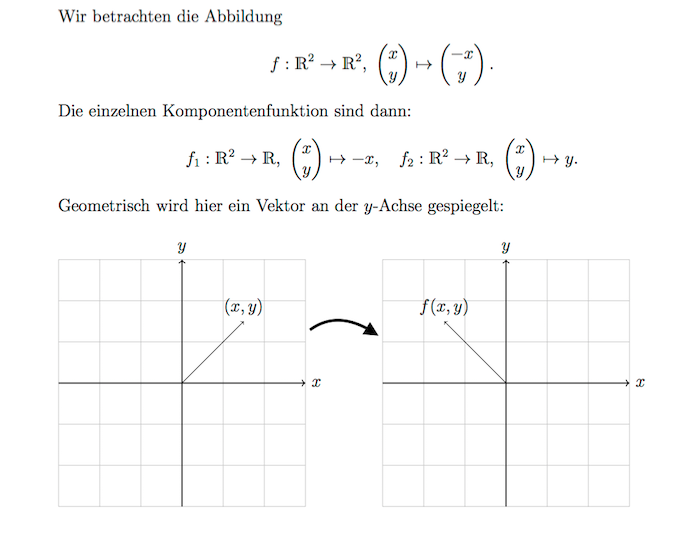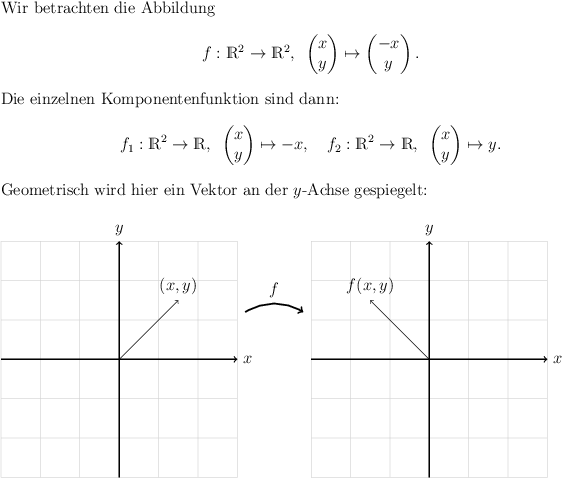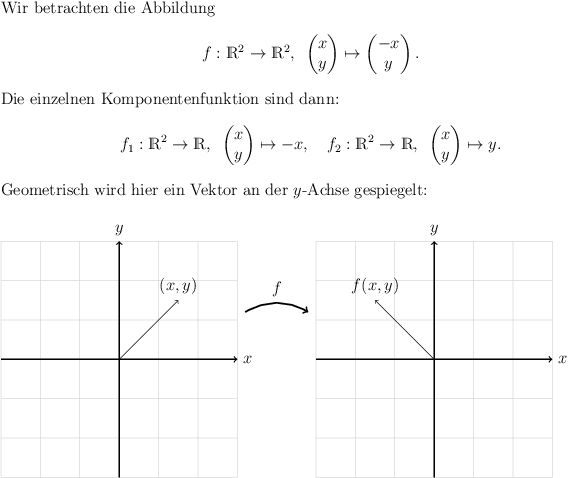|
Hallo, ich habe folgende Skizze in meinem Dokument: \documentclass[12pt,parskip]{scrartcl} \usepackage[english]{babel} \usepackage[utf8]{inputenc} \usepackage{amsmath} \usepackage{graphicx} \usepackage{tikz} \usepackage{dsfont} \begin{document} Wir betrachten die Abbildung \[f:\mathds R^2 \rightarrow\mathds R^2,~\begin{pmatrix} x \\ y \end{pmatrix}\mapsto \begin{pmatrix} -x \\ y \end{pmatrix}.\] Die einzelnen Komponentenfunktion sind dann: \[f_1:\mathds R^2\rightarrow\mathds R,~\begin{pmatrix} x \\ y \end{pmatrix}\mapsto -x,\quad f_2:\mathds R^2\rightarrow\mathds R,~\begin{pmatrix} x \\ y \end{pmatrix}\mapsto y.\] Geometrisch wird hier ein Vektor an der $y$-Achse gespiegelt: \begin{minipage}{.5\linewidth} \begin{tikzpicture} %Koordinatensystem \draw[thin,gray!50] (-3,-3) grid (3,3); \draw[->,thick] (-3,0) -- (3,0) node[right]{$x$}; \draw[->,thick] (0,-3) -- (0,3) node[above]{$y$}; %Vektor \draw[->](0,0) -- (1.5,1.5) node[above]{$(x,y)$}; \end{tikzpicture} \end{minipage}\begin{minipage}{.5\linewidth} \begin{tikzpicture} %Koordinatensystem \draw[thin,gray!50] (-3,-3) grid (3,3); \draw[->,thick] (-3,0) -- (3,0) node[right]{$x$}; \draw[->,thick] (0,-3) -- (0,3) node[above]{$y$}; %Bildvektor \draw[->](0,0) -- (-1.5,1.5) node[above]{$f(x,y)$}; \end{tikzpicture} \end{minipage} \end{document} Ich würde nun gerne zwischen den beiden Bildern einen Pfeil haben, um die Anwendung der Funktion f auf den Vektor zu verdeutlichen (siehe Bild), über dem Pfeil soll auch noch ein f stehen. Ist das möglich?
|
|
Mit TikZ \documentclass[12pt,parskip]{scrartcl} \usepackage[utf8]{inputenc} \usepackage{amsmath} \usepackage{tikz} \usepackage{dsfont} \begin{document} Wir betrachten die Abbildung \[f:\mathds R^2 \rightarrow\mathds R^2,~\begin{pmatrix} x \\ y \end{pmatrix}\mapsto \begin{pmatrix} -x \\ y \end{pmatrix}.\] Die einzelnen Komponentenfunktion sind dann: \[f_1:\mathds R^2\rightarrow\mathds R,~\begin{pmatrix} x \\ y \end{pmatrix}\mapsto -x,\quad f_2:\mathds R^2\rightarrow\mathds R,~\begin{pmatrix} x \\ y \end{pmatrix}\mapsto y.\] Geometrisch wird hier ein Vektor an der $y$-Achse gespiegelt: \begin{minipage}{.5\linewidth} \begin{tikzpicture}[remember picture] \coordinate (A) at (3.2,1.2); % Koordinatensystem \draw[thin,gray!50] (-3,-3) grid (3,3); \draw[->,thick] (-3,0) -- (3,0) node[right]{$x$}; \draw[->,thick] (0,-3) -- (0,3) node[above]{$y$}; % Vektor \draw[->](0,0) -- (1.5,1.5) node[above]{$(x,y)$}; \end{tikzpicture} \end{minipage}% \begin{minipage}{.5\linewidth} \begin{tikzpicture}[remember picture] \coordinate (B) at (-3.2,1.2); % Koordinatensystem \draw[thin,gray!50] (-3,-3) grid (3,3); \draw[->,thick] (-3,0) -- (3,0) node[right]{$x$}; \draw[->,thick] (0,-3) -- (0,3) node[above]{$y$}; % Bildvektor \draw[->](0,0) -- (-1.5,1.5) node[above]{$f(x,y)$}; \end{tikzpicture} \end{minipage} \tikz[remember picture,overlay] \draw[->,very thick] (A) to[bend left] node[above] {$f$} (B); \end{document}
Einfacher geht es, wenn man statt der \documentclass[12pt,parskip]{scrartcl} \usepackage[utf8]{inputenc} \usepackage{amsmath} \usepackage{tikz} \usepackage{dsfont} \begin{document} Wir betrachten die Abbildung \[f:\mathds R^2 \rightarrow\mathds R^2,~\begin{pmatrix} x \\ y \end{pmatrix}\mapsto \begin{pmatrix} -x \\ y \end{pmatrix}.\] Die einzelnen Komponentenfunktion sind dann: \[f_1:\mathds R^2\rightarrow\mathds R,~\begin{pmatrix} x \\ y \end{pmatrix}\mapsto -x,\quad f_2:\mathds R^2\rightarrow\mathds R,~\begin{pmatrix} x \\ y \end{pmatrix}\mapsto y.\] Geometrisch wird hier ein Vektor an der $y$-Achse gespiegelt: \begin{tikzpicture} \begin{scope}[xshift=-4cm] % Koordinatensystem \draw[thin,gray!50] (-3,-3) grid (3,3); \draw[->,thick] (-3,0) -- (3,0) node[right]{$x$}; \draw[->,thick] (0,-3) -- (0,3) node[above]{$y$}; % Vektor \draw[->](0,0) -- (1.5,1.5) node[above]{$(x,y)$}; \end{scope} \draw[->,very thick] (-.8,1.2) to[bend left] node[above] {$f$} (.8,1.2); \begin{scope}[xshift=+4cm] % Koordinatensystem \draw[thin,gray!50] (-3,-3) grid (3,3); \draw[->,thick] (-3,0) -- (3,0) node[right]{$x$}; \draw[->,thick] (0,-3) -- (0,3) node[above]{$y$}; % Bildvektor \draw[->](0,0) -- (-1.5,1.5) node[above]{$f(x,y)$}; \end{scope} \end{tikzpicture} \end{document}
P.S.: Bist du sicher, dass Super, danke! Ich guck mir beide Varianten mal an! Und nein, ich nehme eigenlich usepackage[ngerman]{babel}, der Editor von Overleaf meckert da aber bei mir, dass er das Paket nicht kennt/findet.
(11 Aug '16, 14:19)
Hirshy
|



